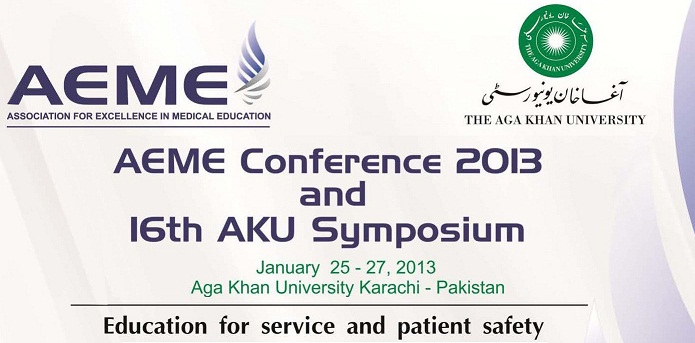Day 1 : Poster Presentations (Theme: Curricular Innovations)
Patient safety: building on opportunities in current MBBS curriculum
Location
Auditorium Pond Side
Start Date
26-1-2013 10:30 AM
Abstract
Background: Healthcare can potentially harm the patient because of human and systems-related errors. Little effort has been made to address patient safety issues although relevant content and therefore opportunities to address it exist in the current undergraduate medical curriculum at the Aga Khan University, Karachi, Pakistan. Our objective is to introduce safety issues enumerated in the WHO Patient Safety Curriculum, in the undergraduate medical curriculum at our university, in a meaningful manner, without encroaching on the current curricular time.
Methods: The entire curriculum of MBBS years 1 to 5 was reviewed. Aspects relevant to patient safety have been identified and it is proposed that they be addressed in appropriate format. Years 3 to 5 I. Aspects for which systems are already in place. These include medication errors (nursing and pharmacy), evidence-based management (pharmacy, wards) • Students may be allowed to attend Patient Safety Task Force meetings and Pharmacy and Therapeutics committee meetings geared to address medication errors and how they are dealt with and review of guidelines and appropriate and inappropriate medication usage (2/year) and submit their reflective notes to their tutor • Year 3, 4 and 5 students to shadow medication nurses during their all clinical rotations (at least 5% of the time during their clinical rotation) and should be signed off by the unit head nurse. Reflective notes to be submitted to the tutor II. Aspects which require planning and faculty training: • Team work during clinical clerkships • Health care associated infections and their prevention
Results: The incorporation of hand hygiene in clinical OSCE in year 3 has served 2 purposes: a reinforcement of the importance of hand hygiene on patient contact and an understanding on the part of organizers to ensure provision of alcohol rub in all clinical OSCEs where hand hygiene is not formally component of a station.
Conclusions: Incorporation of patient safety aspects in undergraduate curriculum from years 1 to 5 may be expected to significantly improve awareness and practice of important patient safety aspects. This is achievable without further taxing the currently overstretched curriculum with faculty training, formally introducing reflective notes for assessment and ensuring that opportunities which exist currently are optimally utilized.
Key words: Patient safety undergraduate curriculum
Patient safety: building on opportunities in current MBBS curriculum
Auditorium Pond Side
Background: Healthcare can potentially harm the patient because of human and systems-related errors. Little effort has been made to address patient safety issues although relevant content and therefore opportunities to address it exist in the current undergraduate medical curriculum at the Aga Khan University, Karachi, Pakistan. Our objective is to introduce safety issues enumerated in the WHO Patient Safety Curriculum, in the undergraduate medical curriculum at our university, in a meaningful manner, without encroaching on the current curricular time.
Methods: The entire curriculum of MBBS years 1 to 5 was reviewed. Aspects relevant to patient safety have been identified and it is proposed that they be addressed in appropriate format. Years 3 to 5 I. Aspects for which systems are already in place. These include medication errors (nursing and pharmacy), evidence-based management (pharmacy, wards) • Students may be allowed to attend Patient Safety Task Force meetings and Pharmacy and Therapeutics committee meetings geared to address medication errors and how they are dealt with and review of guidelines and appropriate and inappropriate medication usage (2/year) and submit their reflective notes to their tutor • Year 3, 4 and 5 students to shadow medication nurses during their all clinical rotations (at least 5% of the time during their clinical rotation) and should be signed off by the unit head nurse. Reflective notes to be submitted to the tutor II. Aspects which require planning and faculty training: • Team work during clinical clerkships • Health care associated infections and their prevention
Results: The incorporation of hand hygiene in clinical OSCE in year 3 has served 2 purposes: a reinforcement of the importance of hand hygiene on patient contact and an understanding on the part of organizers to ensure provision of alcohol rub in all clinical OSCEs where hand hygiene is not formally component of a station.
Conclusions: Incorporation of patient safety aspects in undergraduate curriculum from years 1 to 5 may be expected to significantly improve awareness and practice of important patient safety aspects. This is achievable without further taxing the currently overstretched curriculum with faculty training, formally introducing reflective notes for assessment and ensuring that opportunities which exist currently are optimally utilized.
Key words: Patient safety undergraduate curriculum


